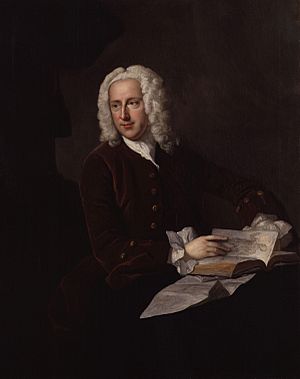Frank Nicholls facts for kids
Frank Nicholls (born 1699, died 1778) was an important English doctor. He became a member of the Royal Society in 1728. This was a group for top scientists. When he was young, he taught anatomy at Oxford University. Later, in the 1730s, he moved to London.
Contents
Life and Discoveries
Frank Nicholls was born in London. His father, John Nicholls, was a lawyer from Cornwall. Frank went to Westminster School and then to Exeter College, Oxford. He studied many subjects, including science. He earned several degrees, becoming a doctor in 1729.
Teaching Anatomy
Even before he finished his medical studies, Frank Nicholls taught anatomy at Oxford. Anatomy is the study of the body's structure. His lectures were very popular. He focused on tiny parts of the body, which was new at the time.
He showed how blood vessels are built. He did experiments to prove that the inner parts of an artery could break while the outer part stayed whole. This helped explain how aneurysms form. An aneurysm is a bulge in a blood vessel. He also noticed that arteries have nerves. He thought these nerves might help control blood pressure.
Frank Nicholls was also the first to make "corroded preparations." This is a special way to study organs. Doctors would inject a substance into a specific part of an organ. Then, they would remove the surrounding parts. This left the injected part standing out clearly.
Moving to London
After working as a doctor in Cornwall for a short time, he moved to London. In 1728, he joined the Royal Society. In 1732, he became a member of the Royal College of Physicians. He traveled to France and Italy to learn more from famous doctors.
When he returned, he started giving anatomy lectures in London. He gave special lectures at the College of Physicians. In 1734, he spoke about the heart and how blood moves. In 1736, he talked about the urinary system and kidney stones.
Royal Physician
In 1753, Frank Nicholls became the doctor for King George II. After the king passed away, Nicholls examined his body. He found a problem with the king's heart. He wrote about this discovery in a letter, which was later published.
Frank Nicholls moved to Oxford in 1762 to help his son with his studies. Later, he lived in Epsom until he died in 1778. He often had fevers and other health issues throughout his life.
His Writings
In 1732, Frank Nicholls published a summary of his lectures in Oxford. In 1738, he made a bigger version in London. It was called 'Compendium Anatomico-œconomicum'. This book was a table-like summary of anatomy, how the body works, diseases, medicines, and childbirth. It had many diagrams.
He is also thought to have written a short book called 'The Petition of the Unborn Babes'. This book was published in 1751. It discussed concerns about early hospitals for mothers and babies. It showed that he had different ideas from some older doctors at the College.
Family Life
Frank Nicholls married Elizabeth, who was the daughter of another doctor, Richard Mead. They had five children together. Only one daughter and one son survived. Their son, John, became a lawyer. He also served as a Member of Parliament (MP) for different areas between 1783 and 1802.


